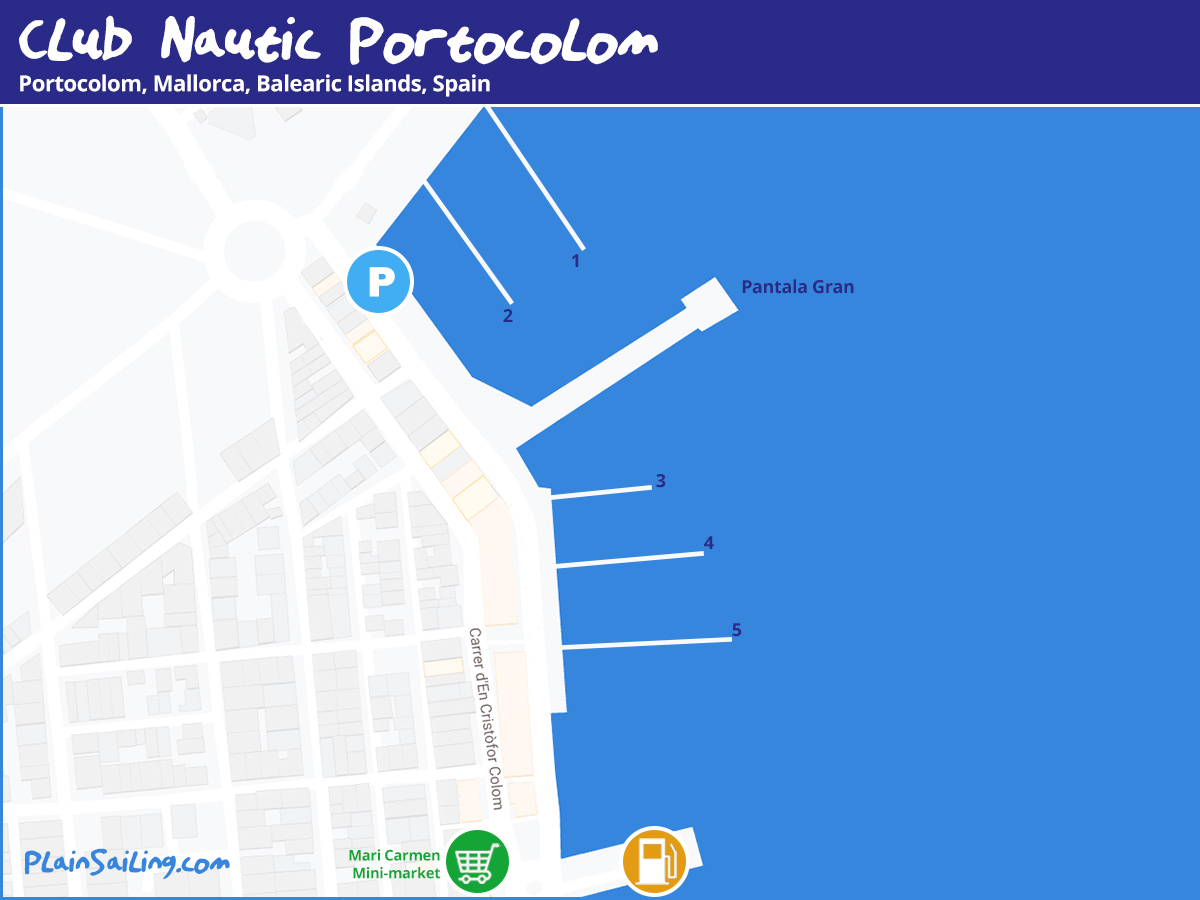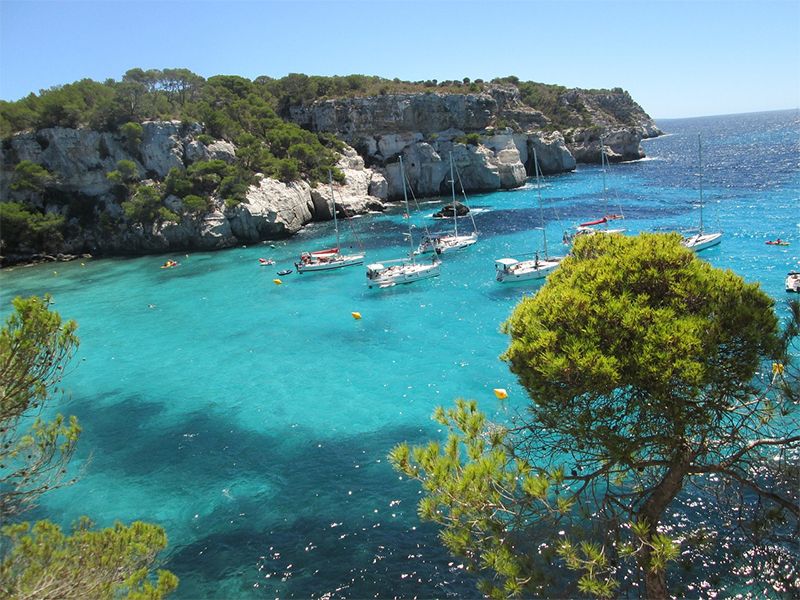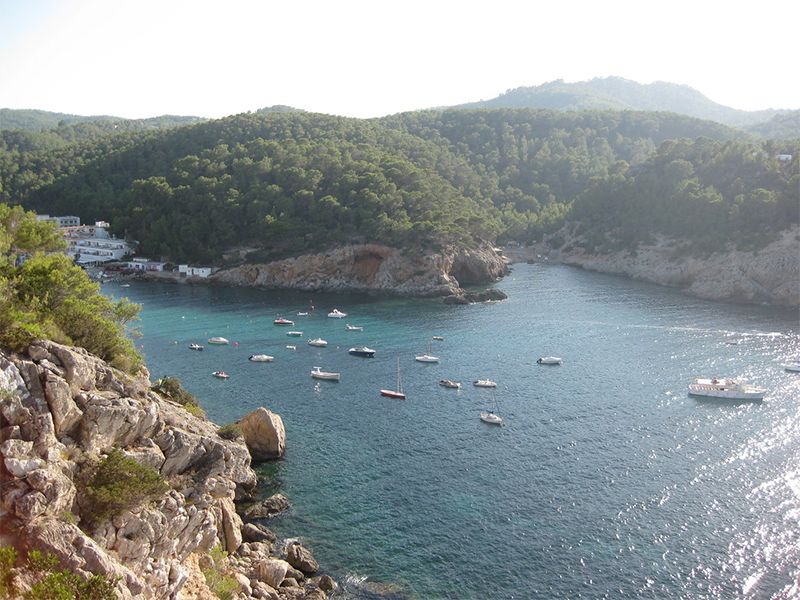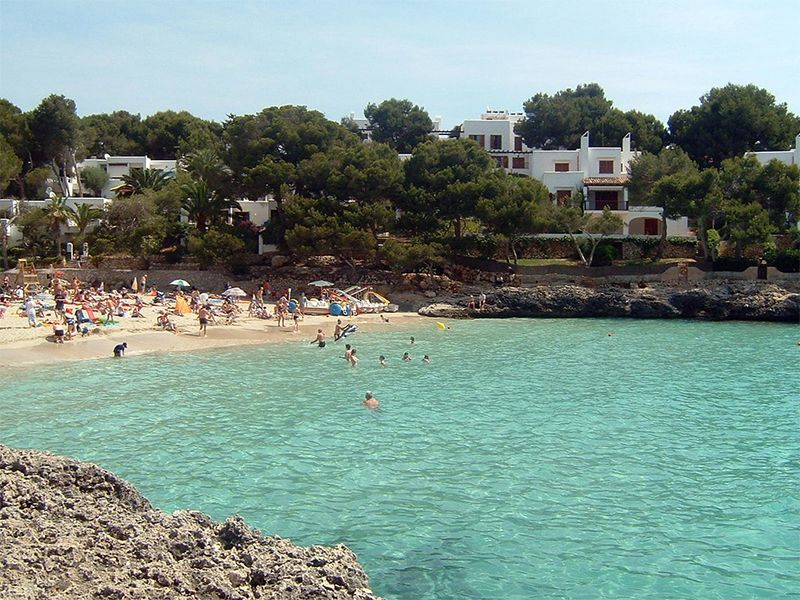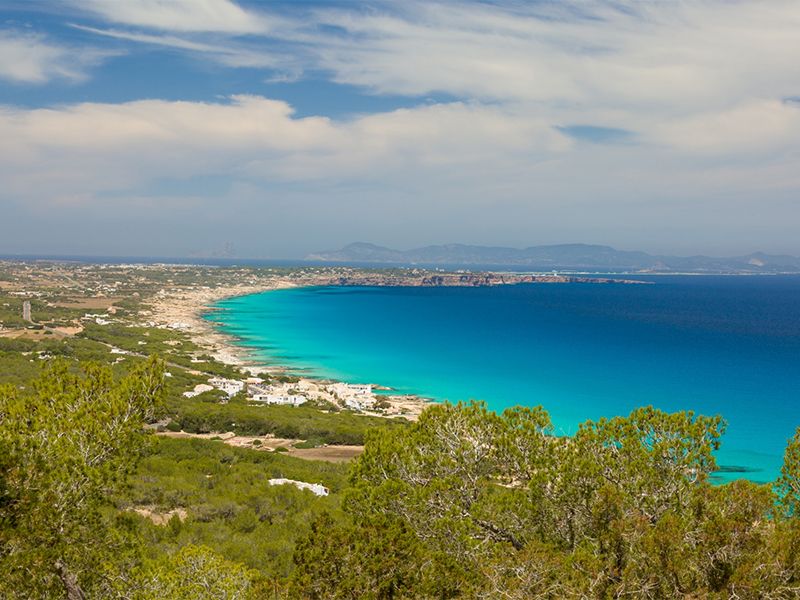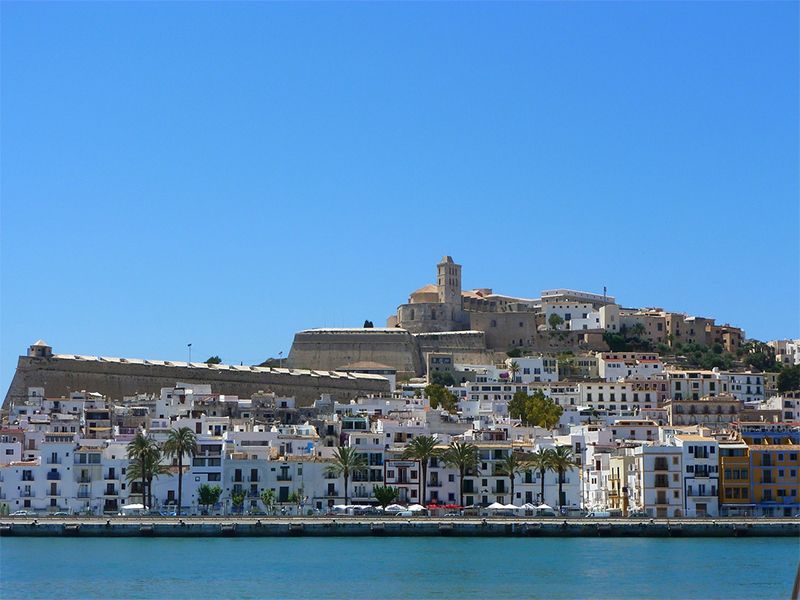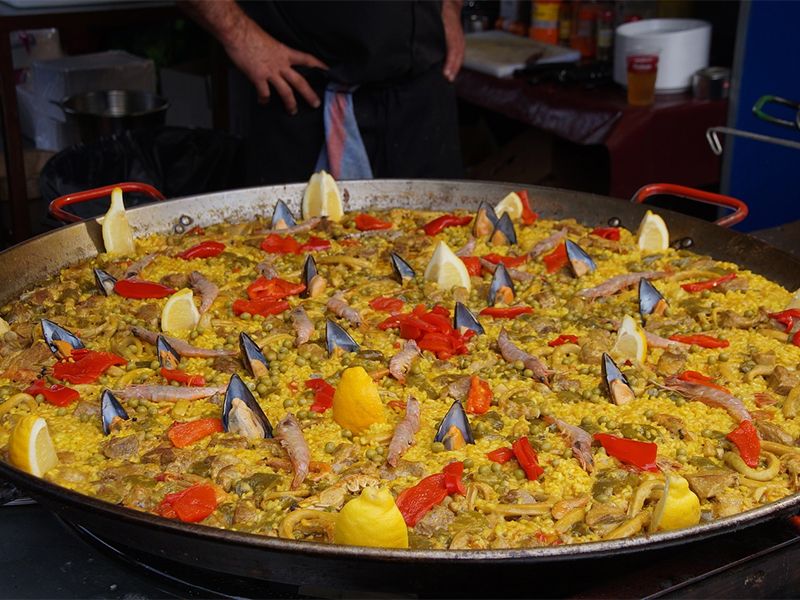6-day Sailing Itinerary from Portocolom
If you’re after sailing in the sunshine with reliable winds, pretty bays, sandy beaches and crystal clear waters, then you came to the right place – because that is exactly what you will get sailing from Portocolom. From here you can sail south and round to Palma (the capital of the island), head north to Alcudia, or hop over to Menorca, Cabrera or even Ibiza. It’s possible to circumnavigate the whole of Mallorca in a week, but at 160 nM it’s a bit of a slog.
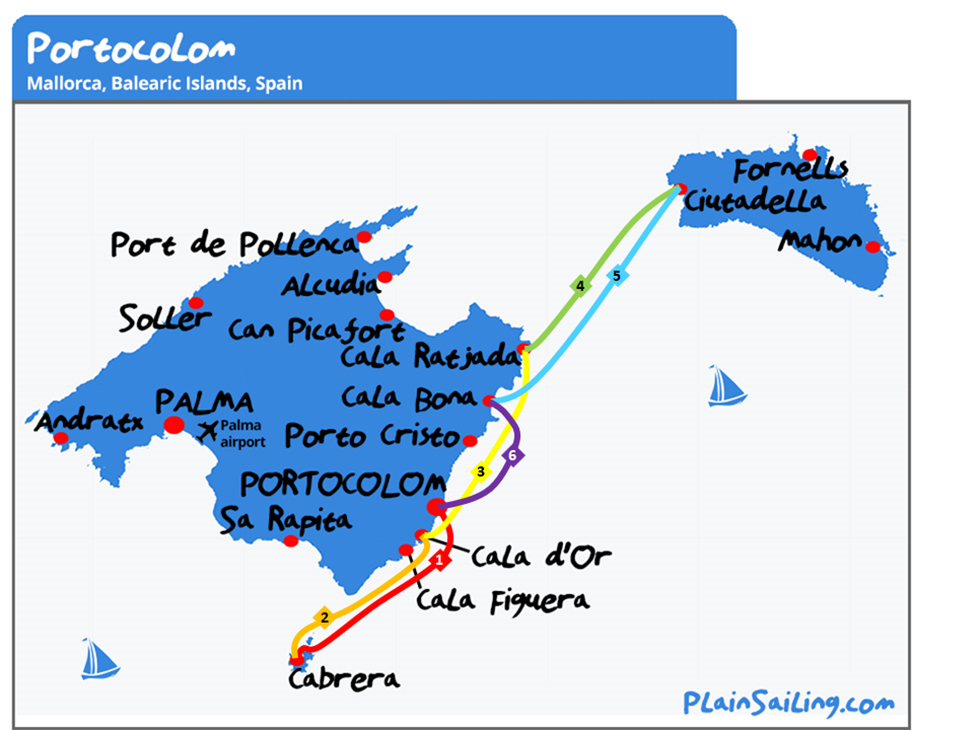 Our six-day itinerary from Portocolom is an island-hopping adventure, and the stunning East coast of Mallorca (the best coast on the island) is supplemented by the natural beauty of Cabrera and the historic town of Ciutadella on Menorca. It’s 138 nM in total, sailing around 25 nM a day, which means sailing for around 5-6 hours a day. This leisurely pace means you’ll have plenty of time to explore the start or end points in more depth, add extra stops for lunch or for diving in, or to just take your time and enjoy the journey.
Our six-day itinerary from Portocolom is an island-hopping adventure, and the stunning East coast of Mallorca (the best coast on the island) is supplemented by the natural beauty of Cabrera and the historic town of Ciutadella on Menorca. It’s 138 nM in total, sailing around 25 nM a day, which means sailing for around 5-6 hours a day. This leisurely pace means you’ll have plenty of time to explore the start or end points in more depth, add extra stops for lunch or for diving in, or to just take your time and enjoy the journey.
It’s only six days because it’s likely you’ll only get on-board in the late afternoon on Saturday, so would be able to get in any meaningful sailing until Sunday morning. The boat will need to returned back to Portocolom on Friday evening at the end of your charter (but you stay on board one last night, before checking out and disembarking the following morning). But what a six days it will be!
Day 1. Portocolom to Cabrera – 24 nM
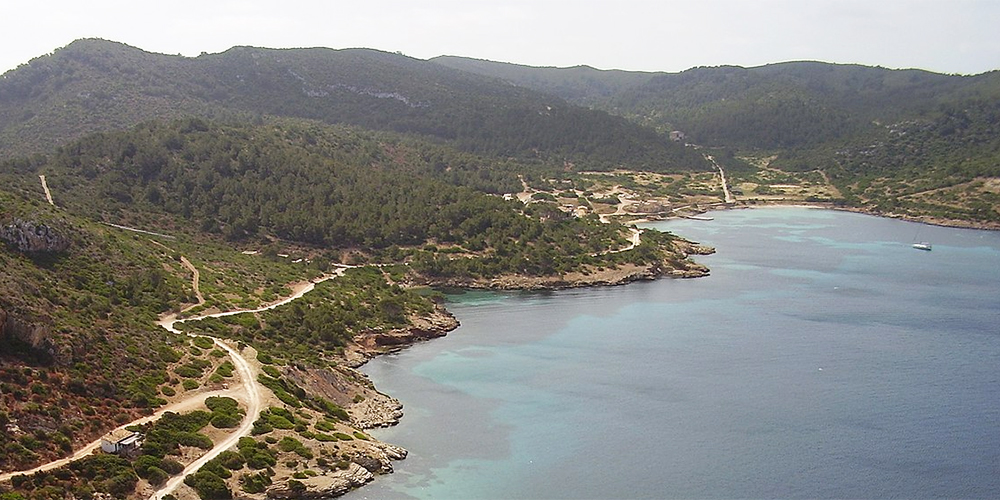 Buenos Dias, Capitan! Bienvenidos to the Balearic islands, and welcome aboard for a week of sailing adventures in the sunshine! Make sure all the crew are on board, and that you have enough food and drink for the next few days, then let’s drop the lines, motor gently away from the pier, and get out of here! When you get out of Portocolom bay then turn to starboard and get the sails up – our destination for the night, Cabrera, is pretty much straight into the prevailing summer winds, so today will be a good day for practicing tacking and explaining how sails work to the rest of the crew.
Buenos Dias, Capitan! Bienvenidos to the Balearic islands, and welcome aboard for a week of sailing adventures in the sunshine! Make sure all the crew are on board, and that you have enough food and drink for the next few days, then let’s drop the lines, motor gently away from the pier, and get out of here! When you get out of Portocolom bay then turn to starboard and get the sails up – our destination for the night, Cabrera, is pretty much straight into the prevailing summer winds, so today will be a good day for practicing tacking and explaining how sails work to the rest of the crew.
Part of the charm of sailing here is about exploring the fantastic coastline and nosing into pretty looking calas for a quick break in-between all the sailing – and there are many along this coast.
Due to its remoteness, Cabrera is an uninhabited island which means that it is largely unspoilt and about as natural a place as you will find in the Med – plants, animals and birds all thrive here. It’s now protected as a nature reserve, so to overnight here you will need to have pre-booked a spot, as places are limited (your charter company can help you do this). Cabrera is a very peaceful place to spend the night, way off the beaten track, and couldn’t be further from the hustle and bustle of normal life – which makes it a great starting place for a sailing holiday.
Day 2. Cabrera to Cala D’Or – 20 nM
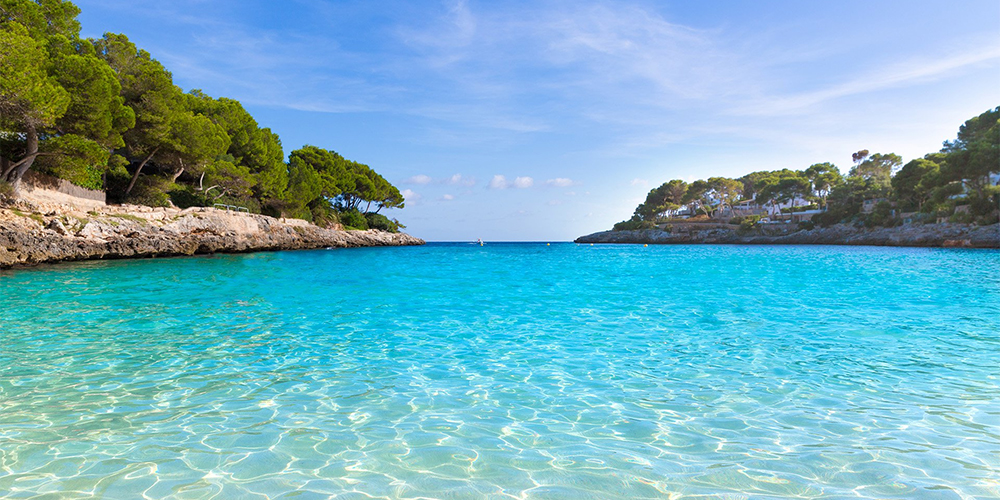 After a tranquil nights’ sleep, we’re heading back to Mallorca. The nearest island you’ll sail past is the ‘Illa de Conills’ or ‘Rabbit island’ (see if you can spot one on there). Oddly enough, they have found evidence of a prehistoric human settlement on this island, but it seems to be an odd place to live, and I can’t imagine they caught many dinosaurs.
After a tranquil nights’ sleep, we’re heading back to Mallorca. The nearest island you’ll sail past is the ‘Illa de Conills’ or ‘Rabbit island’ (see if you can spot one on there). Oddly enough, they have found evidence of a prehistoric human settlement on this island, but it seems to be an odd place to live, and I can’t imagine they caught many dinosaurs.
Anyway, we’re sailing onwards and upwards to Cala D’Or. The winds here get very confused as they arrive from the north to the west of Mallorca, then swing round to head off East, so you’ll likely be tinkering with your sails as you bob towards the island, and then running with the wind up the East coast when you get around the corner.
We’re heading to the sheltered cove of Cala D’Or (‘Golden Cala’ in English), which comprises three in-land bays (the marina is in the port side one as you enter). Once a cute fishing village, Cala D’Or is now popular with land-lubbing tourists, who are predominantly here for the seven picturesque golden sandy beaches, lush pine forests, and turquoise blue seas. There’s plenty of options of places to eat or drink, and the town itself has managed to retain a fair chunk of authentic Mallorcan charm, so is worth a stroll.
Day 3. Cala D’Or to Cala Ratjada – 24 nM
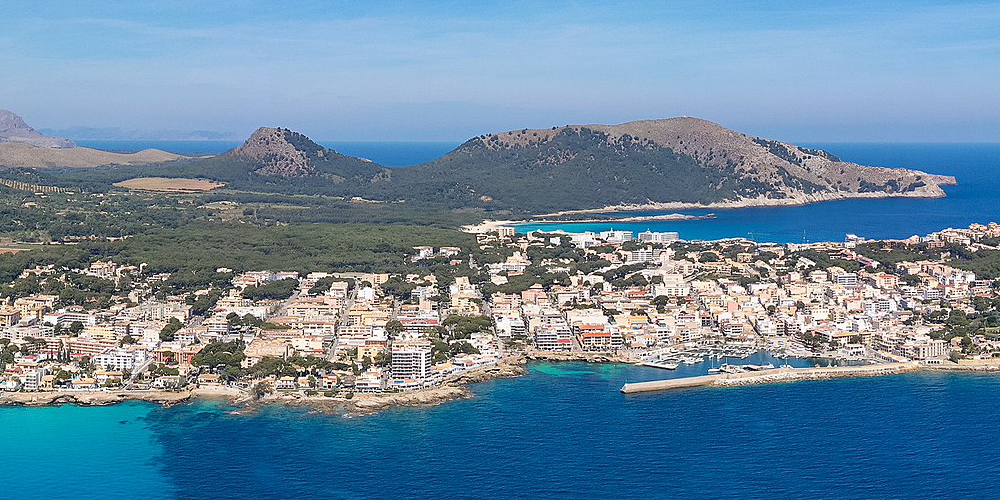 Most of the Mallorcan coastline is dedicated to tourism these days – for the obvious reason that it’s a beautiful place to be, and worth travelling for. Today we’re skipping from Cala D’Or, which is unashamedly centred around tourists up the coastline to Cala Ratjada, which is the nearest port to Menorca and still very much a working fishing village.
Most of the Mallorcan coastline is dedicated to tourism these days – for the obvious reason that it’s a beautiful place to be, and worth travelling for. Today we’re skipping from Cala D’Or, which is unashamedly centred around tourists up the coastline to Cala Ratjada, which is the nearest port to Menorca and still very much a working fishing village.
You’ll still spot a few tourists, because it’s right next to Cala Gat (which is arguably the best beach on the island), but much of the town is as it used to be before tourism arrived in the 1950’s. To get there, we’re running with the wind north-easterly up the coast, passing Portocolom amongst other calas. and onwards to Cala Ratjada, the most Eastern part of Mallorca, and the place where goods are sent to, and arrive from, neighbouring Menorca (which you can see on the horizon on a clear day – but don’t worry, we’re heading there next).
If you’re feeling energetic, there’s a fine view from Capdepera lighthouse (literally as far East as you can go on the island), or you can head to the Sa Torre sculpture gardens which include exhibits from some well-known sculptors including Henry Moore. As you’ll probably work out from a walk around the town, the village is particularly well known for its lobster – it’s locally-caught and delicious!
Day 4. Cala Ratjada to Ciutadella – 23 nM
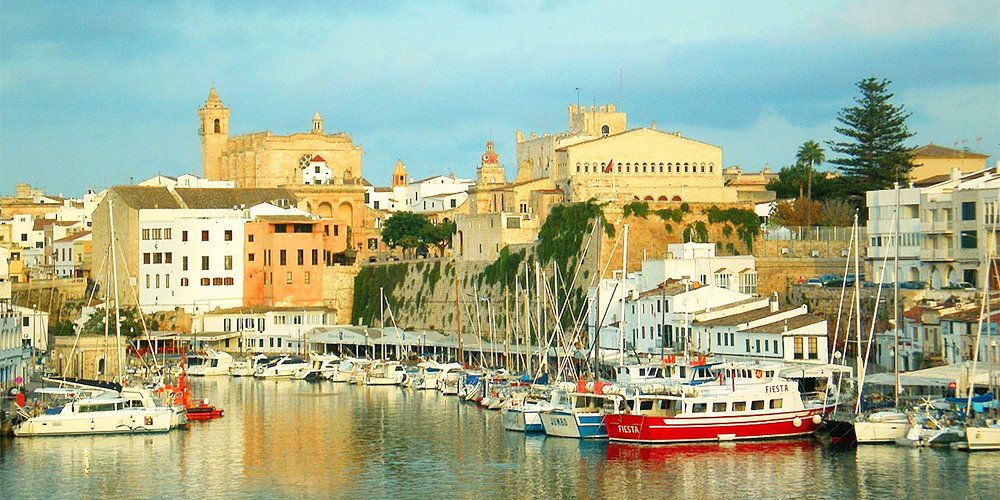 Cala Ratjada might have been an important port in Mallorca, but it is relatively insignificant compared to our next port of call, Ciutadella de Menorca, which at one time was a massively important trading town on the Med, and capital of the Balearic islands – and there is impressive architecture to prove it.
Cala Ratjada might have been an important port in Mallorca, but it is relatively insignificant compared to our next port of call, Ciutadella de Menorca, which at one time was a massively important trading town on the Med, and capital of the Balearic islands – and there is impressive architecture to prove it.
Being such an important town, it also has a gruesome history, as it has changed hands in bloody battles many times through the years – it has been held by the Carthaginians, Moors (for centuries), French and has even been won (and lost) as part of the British empire on three separate occasions. The most brutal takeover was by the Turks in 1558, who not only razed much of the buildings to the ground, but also took every single person they found on the island back to Istanbul, where they were sold as slaves.
Nowadays, the harbour is a peaceful place, and it is the centre-piece of a charming old town, with narrow atmospheric streets, fine churches, and welcoming plazas. It’s largely unspoilt by tourism because the island was a Republican stronghold in the Spanish Civil war, and the Spanish nationalist dictator General Franco thought he was punishing them and their economy by not allowing them to build the sort of ugly high-rise tourist apartments and hotels which are commonplace across Spanish tourist resorts – in hindsight, perhaps not such a punishment after all.
Day 5. Ciutadella to Cala Bona – 32 nM
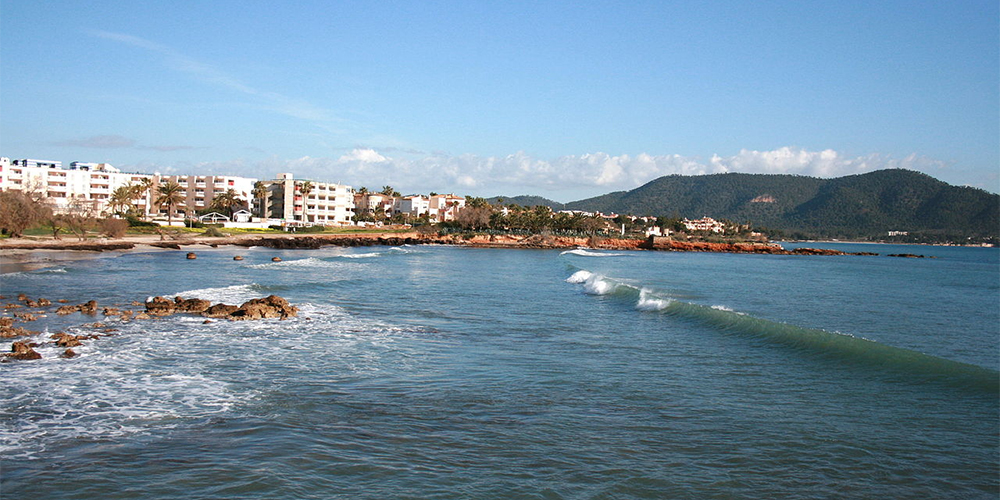 Today is the longest leg of sailing, and we’re hopping our back to Mallorca, tacking up the prevailing summer winds, although, similar to the zone between Cabrera and Mallorca, the dominant winds can be from almost any direction here, and it can change every few minutes. It would be nice to sail to Mahon, capital of Menorca, but Ciutadella is a much nicer and more authentic place to visit if you’re only there for one night.
Today is the longest leg of sailing, and we’re hopping our back to Mallorca, tacking up the prevailing summer winds, although, similar to the zone between Cabrera and Mallorca, the dominant winds can be from almost any direction here, and it can change every few minutes. It would be nice to sail to Mahon, capital of Menorca, but Ciutadella is a much nicer and more authentic place to visit if you’re only there for one night.
We’re sailing back past Cala Ratjada (nose in to Cala Gat for a swim if you have time – like I said, it is supposed to be the best beach on the island), and onwards down to Cala Bona, which as little as 60 years ago was a handful of wooden fishing buildings, but is now combined into a big tourist zone with neighbouring Cala Millor, with all the facilities, shops, restaurants and bars that that entails – as well as a reasonably modern marina.
There’s a few nice beaches within walking distance, but there’s also some nice bars along the waterfront, and even overlooking the marina, which are a pleasant place to sit and watch the world go by, particularly after a decent leg at sea.
Day 6. Cala Bona to Portocolom (via Porto Cristo) – 15 nM
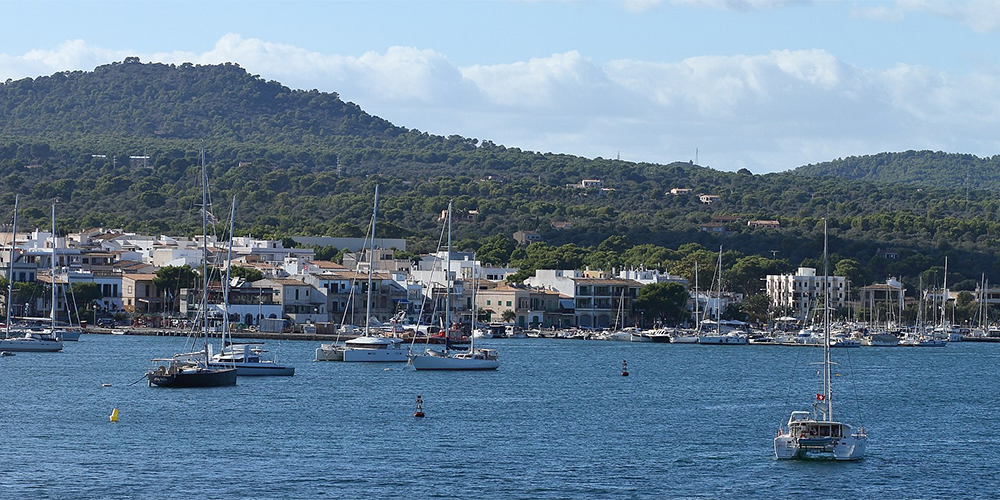 Wait, it’s the last day already? Where did the time go?! That means that we have to get the boat tucked up back in Portocolom by this evening (but you can stay overnight on the boat and check out in the morning). It’s not a huge distance to cover in a glorious day of sailing, which means you can take your time and sail at a leisurely pace. On the way, you can stop off at the wonderful town of Porto Cristo – so named because an abandoned fishing boat with a crucifix in got washed up on the shore here in 1260. If you stop here, then you’ll be within 5km of where a certain Rafael Nadal, champion tennis player, was born (in Manacor), and he lives in a swanky villa in the area.
Wait, it’s the last day already? Where did the time go?! That means that we have to get the boat tucked up back in Portocolom by this evening (but you can stay overnight on the boat and check out in the morning). It’s not a huge distance to cover in a glorious day of sailing, which means you can take your time and sail at a leisurely pace. On the way, you can stop off at the wonderful town of Porto Cristo – so named because an abandoned fishing boat with a crucifix in got washed up on the shore here in 1260. If you stop here, then you’ll be within 5km of where a certain Rafael Nadal, champion tennis player, was born (in Manacor), and he lives in a swanky villa in the area.
Then onwards to Portocolom, not forgetting to fill up at the fuel berth in the bay before returning the boat back to where you found her. Attached the lines, turn off the engine, and we’re done. Hopefully you’ve had a fantastic week exploring Mallorca, eating the seafood, and enjoying time with your crew. The sign of a good sailing holiday is that you’re already talking about where you want to go sailing together next time – in which case, check out the other places you can sail on PlainSailing.com.
If you haven’t yet had chance to explore Portocolom, then it’s a quiet small holiday town which has a few restaurants and bars. Most people come here to spend the day at Cala Marcal beach. And then it’s time to leave the boat, taking with you the memories of a life at sea, and leaving with better friends than you arrived with. Have a safe trip home, and hopefully see you online soon :)
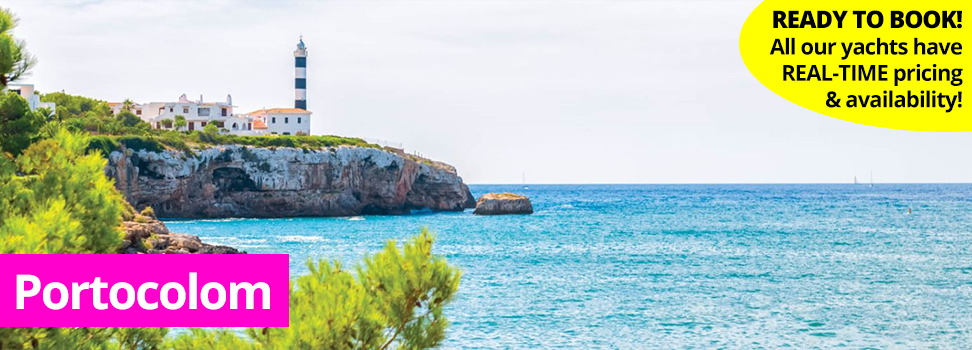
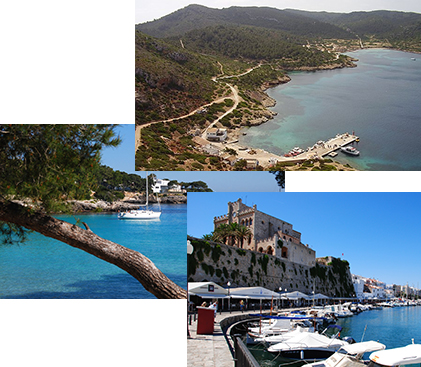

 Buenos Dias, Capitan! Bienvenidos to the Balearic islands, and welcome aboard for a week of sailing adventures in the sunshine! Make sure all the crew are on board, and that you have enough food and drink for the next few days, then let’s drop the lines, motor gently away from the pier, and get out of here! When you get out of Portocolom bay then turn to starboard and get the sails up – our destination for the night, Cabrera, is pretty much straight into the prevailing summer winds, so today will be a good day for practicing tacking and explaining how sails work to the rest of the crew.
Buenos Dias, Capitan! Bienvenidos to the Balearic islands, and welcome aboard for a week of sailing adventures in the sunshine! Make sure all the crew are on board, and that you have enough food and drink for the next few days, then let’s drop the lines, motor gently away from the pier, and get out of here! When you get out of Portocolom bay then turn to starboard and get the sails up – our destination for the night, Cabrera, is pretty much straight into the prevailing summer winds, so today will be a good day for practicing tacking and explaining how sails work to the rest of the crew.  After a tranquil nights’ sleep, we’re heading back to Mallorca. The nearest island you’ll sail past is the ‘Illa de Conills’ or ‘Rabbit island’ (see if you can spot one on there). Oddly enough, they have found evidence of a prehistoric human settlement on this island, but it seems to be an odd place to live, and I can’t imagine they caught many dinosaurs.
After a tranquil nights’ sleep, we’re heading back to Mallorca. The nearest island you’ll sail past is the ‘Illa de Conills’ or ‘Rabbit island’ (see if you can spot one on there). Oddly enough, they have found evidence of a prehistoric human settlement on this island, but it seems to be an odd place to live, and I can’t imagine they caught many dinosaurs.  Most of the Mallorcan coastline is dedicated to tourism these days – for the obvious reason that it’s a beautiful place to be, and worth travelling for. Today we’re skipping from Cala D’Or, which is unashamedly centred around tourists up the coastline to Cala Ratjada, which is the nearest port to Menorca and still very much a working fishing village.
Most of the Mallorcan coastline is dedicated to tourism these days – for the obvious reason that it’s a beautiful place to be, and worth travelling for. Today we’re skipping from Cala D’Or, which is unashamedly centred around tourists up the coastline to Cala Ratjada, which is the nearest port to Menorca and still very much a working fishing village.  Cala Ratjada might have been an important port in Mallorca, but it is relatively insignificant compared to our next port of call, Ciutadella de Menorca, which at one time was a massively important trading town on the Med, and capital of the Balearic islands – and there is impressive architecture to prove it.
Cala Ratjada might have been an important port in Mallorca, but it is relatively insignificant compared to our next port of call, Ciutadella de Menorca, which at one time was a massively important trading town on the Med, and capital of the Balearic islands – and there is impressive architecture to prove it.  Today is the longest leg of sailing, and we’re hopping our back to Mallorca, tacking up the prevailing summer winds, although, similar to the zone between Cabrera and Mallorca, the dominant winds can be from almost any direction here, and it can change every few minutes. It would be nice to sail to Mahon, capital of Menorca, but Ciutadella is a much nicer and more authentic place to visit if you’re only there for one night.
Today is the longest leg of sailing, and we’re hopping our back to Mallorca, tacking up the prevailing summer winds, although, similar to the zone between Cabrera and Mallorca, the dominant winds can be from almost any direction here, and it can change every few minutes. It would be nice to sail to Mahon, capital of Menorca, but Ciutadella is a much nicer and more authentic place to visit if you’re only there for one night. Wait, it’s the last day already? Where did the time go?! That means that we have to get the boat tucked up back in Portocolom by this evening (but you can stay overnight on the boat and check out in the morning). It’s not a huge distance to cover in a glorious day of sailing, which means you can take your time and sail at a leisurely pace. On the way, you can stop off at the wonderful town of Porto Cristo – so named because an abandoned fishing boat with a crucifix in got washed up on the shore here in 1260. If you stop here, then you’ll be within 5km of where a certain Rafael Nadal, champion tennis player, was born (in Manacor), and he lives in a swanky villa in the area.
Wait, it’s the last day already? Where did the time go?! That means that we have to get the boat tucked up back in Portocolom by this evening (but you can stay overnight on the boat and check out in the morning). It’s not a huge distance to cover in a glorious day of sailing, which means you can take your time and sail at a leisurely pace. On the way, you can stop off at the wonderful town of Porto Cristo – so named because an abandoned fishing boat with a crucifix in got washed up on the shore here in 1260. If you stop here, then you’ll be within 5km of where a certain Rafael Nadal, champion tennis player, was born (in Manacor), and he lives in a swanky villa in the area. .jpg)
 The weather in Portocolom is fantastic – there’s sunshine pretty much all year round. It’s t-shirt weather from around April, but things start hotting up from mid-May. It’s warmer still in June, and in July and August then it’s so hot and sunny that there is no excuse not to dive into the sea, or help yourself to a nice cool drink or an ice-cream. September and October are still pleasant times to sail.
The weather in Portocolom is fantastic – there’s sunshine pretty much all year round. It’s t-shirt weather from around April, but things start hotting up from mid-May. It’s warmer still in June, and in July and August then it’s so hot and sunny that there is no excuse not to dive into the sea, or help yourself to a nice cool drink or an ice-cream. September and October are still pleasant times to sail.
